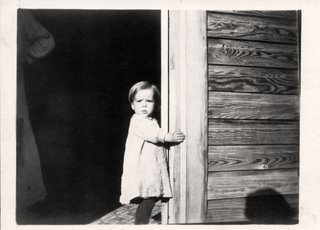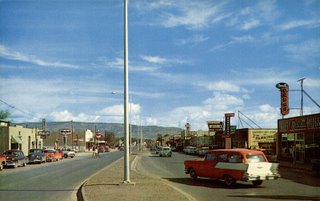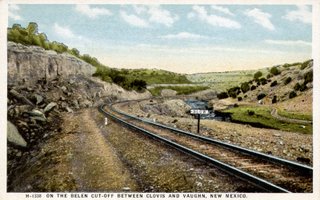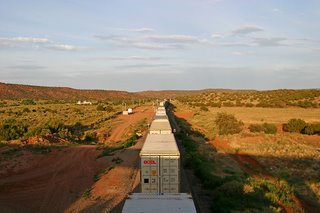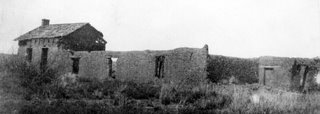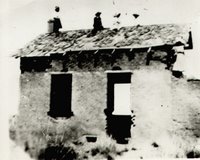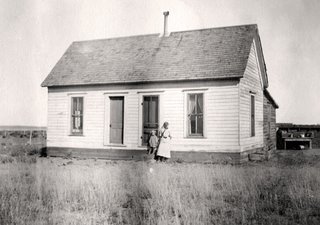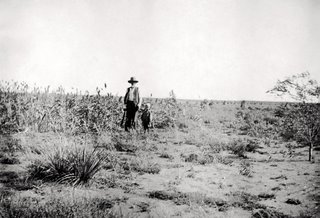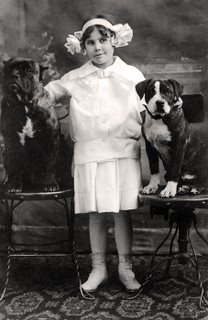Dawson, New Mexico ca 1910.
Jumping to Conclusions
 The inspiration for the postcard above is, as stated on the back, a stunt performed by a park ranger at Grand Canyon, Arizona. However, it looks suspiciously similar to a famous photograph (pictured below) taken by H. H. Bennett of Wisconsin in 1885. The card is postmarked 1948, 63 years after Bennett's effort - and 40 years after his death. Is it just a coincidence? I don't know about you, but I'm not prepared to make that leap.
The inspiration for the postcard above is, as stated on the back, a stunt performed by a park ranger at Grand Canyon, Arizona. However, it looks suspiciously similar to a famous photograph (pictured below) taken by H. H. Bennett of Wisconsin in 1885. The card is postmarked 1948, 63 years after Bennett's effort - and 40 years after his death. Is it just a coincidence? I don't know about you, but I'm not prepared to make that leap.
"Oldest House in the U.S."
Belen High School 1937


Today we have a bit of ephemera from the high school in Belen, New Mexico - a student's registration card from 1937. The front of the card shows the student's name, address, & her parent's occupations: father unemployed (tactfully left blank), mother comptometer operator. The back of the card shows her teachers and schedule.
Pig Pen Scenery
 With the advent of roll film, photography became affordable to the masses. No longer did one have to hire a professional to have a picture made, though the pro's still made a better photograph. People took to casual photography with enthusiasm, snapping images of everything in sight. They were so casual about it that a strange thing happened, they began to smile for the camera. The dour poses of old were forgotten; one could always take a serious picture later on. This explosion in image making has been a boon for historians and the such, who now have millions of pictures from the last hundred years to mull over. Even from the picture above we can learn that, A. Small Southwestern framers raised pigs, and B. Yes, pioneers did smile - at least occasionally.
With the advent of roll film, photography became affordable to the masses. No longer did one have to hire a professional to have a picture made, though the pro's still made a better photograph. People took to casual photography with enthusiasm, snapping images of everything in sight. They were so casual about it that a strange thing happened, they began to smile for the camera. The dour poses of old were forgotten; one could always take a serious picture later on. This explosion in image making has been a boon for historians and the such, who now have millions of pictures from the last hundred years to mull over. Even from the picture above we can learn that, A. Small Southwestern framers raised pigs, and B. Yes, pioneers did smile - at least occasionally.Photo: "Pig Pen Scenery" Quay County, New Mexico ca. 1913.
Howling Coyote
 The imagery used in the tourism industry hasn't changed much over the years. Even though our ideas on race, and history, and wildlife have changed, the pictures remain the same. And why wouldn't they? People still go to the Southwest to see coyotes, pueblos, and old missions, just like they still go to Washington D.C. to see the White House, or to Lancaster, PA to see the Amish. Our attitudes have changed, but not our curiosity.
The imagery used in the tourism industry hasn't changed much over the years. Even though our ideas on race, and history, and wildlife have changed, the pictures remain the same. And why wouldn't they? People still go to the Southwest to see coyotes, pueblos, and old missions, just like they still go to Washington D.C. to see the White House, or to Lancaster, PA to see the Amish. Our attitudes have changed, but not our curiosity.Photo: Postcard 1930's
The Old Court House & Jail
Katson's Drive-In
 Back in the middle part of the twentieth century, it was popular to be waited on by majorettes. It was around this same time that comic book heroes, dressed in union suits, became all the rage. Somehow I think there's a connection.
Back in the middle part of the twentieth century, it was popular to be waited on by majorettes. It was around this same time that comic book heroes, dressed in union suits, became all the rage. Somehow I think there's a connection.Photo: Postcard Front, "Katson's Drive - In, Albuquerque, N.M." Rear, "Katson's Drive - In Restaurant and Curio Shop. Curb, Coffee Shop, Dining Room. Around the Clock Service. On U.S. HiWay 66 West of Albuquerque. In the center of the fine Tourist Court Section." Postmark: 7/21/41
Mesa Redonda

"Mesa Redonda" is Spanish for "round mesa," but this is actually two mesas facing each other. One is shaped like a horseshoe and the other is slightly rounded. At one time, Mesa Redonda was the ideal hangout for a gang of outlaws and cattle thieves, which was broken up by posses in the early 1890s. The area was also used by the early settlers for ranching, and it was described as having only two cattle trails leading to the top." (From nenewmexico.com)
Photo: Postcard "Sand Rock Sisterns, Mesa Redonda, N. Mex." (cisterns is spelled wrong) Nowell Photo (Dawson, New Mexico) ca. 1916
Fort Bascom 1907
Vacations for all
 Going through these old photographs, I'm often struck by what a time of transition the turn of the twentieth century seemed to be for homesteaders. A person may be slopping the pigs in the morning and on vacation in the afternoon. Granted, there was much more hog tending than pleasure trips, but the evidence in these and other pictures seems to point to the fact that 20th century concepts like tourism and consumerism (for the masses), came very rapidly - even to the Southern Great Plains.
Going through these old photographs, I'm often struck by what a time of transition the turn of the twentieth century seemed to be for homesteaders. A person may be slopping the pigs in the morning and on vacation in the afternoon. Granted, there was much more hog tending than pleasure trips, but the evidence in these and other pictures seems to point to the fact that 20th century concepts like tourism and consumerism (for the masses), came very rapidly - even to the Southern Great Plains.Photo: Seven Falls, Colorado 1913
Federal Land Patents

If you have relatives or ancestors who were homesteaders, or perhaps you live on land that was once under the Homestead Act, you can get free copies of the original land patents from the U.S. Government. Just go to the The Official Federal Land Records Site and click on "Search Land Patents" at the bottom of the page. If your search is successful, you will be presented with the basic patent info and several choices of downloadable images of the document, or for the very reasonable price of $2.00, you can even have a "Certified Copy" of the original patent mailed to you. There is also a good FAQ that can answer anything I haven't already mentioned.
Little houses
Rain on demand
NPS Historical Handbook: Fort Union
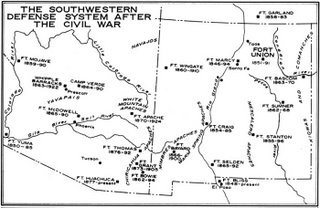 "THE RUINS OF FORT UNION graphically commemorate the achievements of the men who won the West. Located on the route of the Santa Fe Trail where the mountains meet the plains, the fort is centered in a region full of historic events and brimming with the romance of the frontier. As a base of operations for both military and civilian ventures in New Mexico for 40 years, 1851 to 1891, Fort Union played a key role in shaping the destiny of the Southwest." Read On.
"THE RUINS OF FORT UNION graphically commemorate the achievements of the men who won the West. Located on the route of the Santa Fe Trail where the mountains meet the plains, the fort is centered in a region full of historic events and brimming with the romance of the frontier. As a base of operations for both military and civilian ventures in New Mexico for 40 years, 1851 to 1891, Fort Union played a key role in shaping the destiny of the Southwest." Read On.
Subscribe to:
Comments (Atom)


